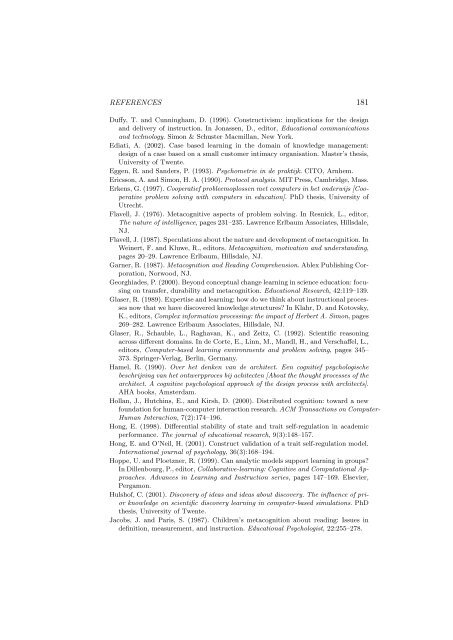The role of metacognitive skills in learning to solve problems
The role of metacognitive skills in learning to solve problems
The role of metacognitive skills in learning to solve problems
You also want an ePaper? Increase the reach of your titles
YUMPU automatically turns print PDFs into web optimized ePapers that Google loves.
REFERENCES 181<br />
Duffy, T. and Cunn<strong>in</strong>gham, D. (1996). Constructivism: implications for the design<br />
and delivery <strong>of</strong> <strong>in</strong>struction. In Jonassen, D., edi<strong>to</strong>r, Educational communications<br />
and technology. Simon & Schuster Macmillan, New York.<br />
Ediati, A. (2002). Case based learn<strong>in</strong>g <strong>in</strong> the doma<strong>in</strong> <strong>of</strong> knowledge management:<br />
design <strong>of</strong> a case based on a small cus<strong>to</strong>mer <strong>in</strong>timacy organisation. Master’s thesis,<br />
University <strong>of</strong> Twente.<br />
Eggen, R. and Sanders, P. (1993). Psychometrie <strong>in</strong> de praktijk. CITO, Arnhem.<br />
Ericsson, A. and Simon, H. A. (1990). Pro<strong>to</strong>col analysis. MIT Press, Cambridge, Mass.<br />
Erkens, G. (1997). Cooperatief probleemoplossen met computers <strong>in</strong> het onderwijs [Cooperative<br />
problem solv<strong>in</strong>g with computers <strong>in</strong> education]. PhD thesis, University <strong>of</strong><br />
Utrecht.<br />
Flavell, J. (1976). Metacognitive aspects <strong>of</strong> problem solv<strong>in</strong>g. In Resnick, L., edi<strong>to</strong>r,<br />
<strong>The</strong> nature <strong>of</strong> <strong>in</strong>telligence, pages 231–235. Lawrence Erlbaum Associates, Hillsdale,<br />
NJ.<br />
Flavell, J. (1987). Speculations about the nature and development <strong>of</strong> metacognition. In<br />
We<strong>in</strong>ert, F. and Kluwe, R., edi<strong>to</strong>rs, Metacognition, motivation and understand<strong>in</strong>g,<br />
pages 20–29. Lawrence Erlbaum, Hillsdale, NJ.<br />
Garner, R. (1987). Metacognition and Read<strong>in</strong>g Comprehension. Ablex Publish<strong>in</strong>g Corporation,<br />
Norwood, NJ.<br />
Georghiades, P. (2000). Beyond conceptual change learn<strong>in</strong>g <strong>in</strong> science education: focus<strong>in</strong>g<br />
on transfer, durability and metacognition. Educational Research, 42:119–139.<br />
Glaser, R. (1989). Expertise and learn<strong>in</strong>g: how do we th<strong>in</strong>k about <strong>in</strong>structional processes<br />
now that we have discovered knowledge structures? In Klahr, D. and Ko<strong>to</strong>vsky,<br />
K., edi<strong>to</strong>rs, Complex <strong>in</strong>formation process<strong>in</strong>g: the impact <strong>of</strong> Herbert A. Simon, pages<br />
269–282. Lawrence Erlbaum Associates, Hillsdale, NJ.<br />
Glaser, R., Schauble, L., Raghavan, K., and Zeitz, C. (1992). Scientific reason<strong>in</strong>g<br />
across different doma<strong>in</strong>s. In de Corte, E., L<strong>in</strong>n, M., Mandl, H., and Verschaffel, L.,<br />
edi<strong>to</strong>rs, Computer-based learn<strong>in</strong>g environments and problem solv<strong>in</strong>g, pages 345–<br />
373. Spr<strong>in</strong>ger-Verlag, Berl<strong>in</strong>, Germany.<br />
Hamel, R. (1990). Over het denken van de architect. Een cognitief psychologische<br />
beschrijv<strong>in</strong>g van het ontwerpproces bij achitecten [About the thought processes <strong>of</strong> the<br />
architect. A cognitive psychological approach <strong>of</strong> the design process with architects].<br />
AHA books, Amsterdam.<br />
Hollan, J., Hutch<strong>in</strong>s, E., and Kirsh, D. (2000). Distributed cognition: <strong>to</strong>ward a new<br />
foundation for human-computer <strong>in</strong>teraction research. ACM Transactions on Computer-<br />
Human Interaction, 7(2):174–196.<br />
Hong, E. (1998). Differential stability <strong>of</strong> state and trait self-regulation <strong>in</strong> academic<br />
performance. <strong>The</strong> journal <strong>of</strong> educational research, 9(3):148–157.<br />
Hong, E. and O’Neil, H. (2001). Construct validation <strong>of</strong> a trait self-regulation model.<br />
International journal <strong>of</strong> psychology, 36(3):168–194.<br />
Hoppe, U. and Ploetzner, R. (1999). Can analytic models support learn<strong>in</strong>g <strong>in</strong> groups?<br />
In Dillenbourg, P., edi<strong>to</strong>r, Collaborative-learn<strong>in</strong>g: Cognitive and Computational Approaches.<br />
Advances <strong>in</strong> Learn<strong>in</strong>g and Instruction series, pages 147–169. Elsevier,<br />
Pergamon.<br />
Hulsh<strong>of</strong>, C. (2001). Discovery <strong>of</strong> ideas and ideas about discovery. <strong>The</strong> <strong>in</strong>fluence <strong>of</strong> prior<br />
knowledge on scientific discovery learn<strong>in</strong>g <strong>in</strong> computer-based simulations. PhD<br />
thesis, University <strong>of</strong> Twente.<br />
Jacobs, J. and Paris, S. (1987). Children’s metacognition about read<strong>in</strong>g: Issues <strong>in</strong><br />
def<strong>in</strong>ition, measurement, and <strong>in</strong>struction. Educational Psychologist, 22:255–278.
















